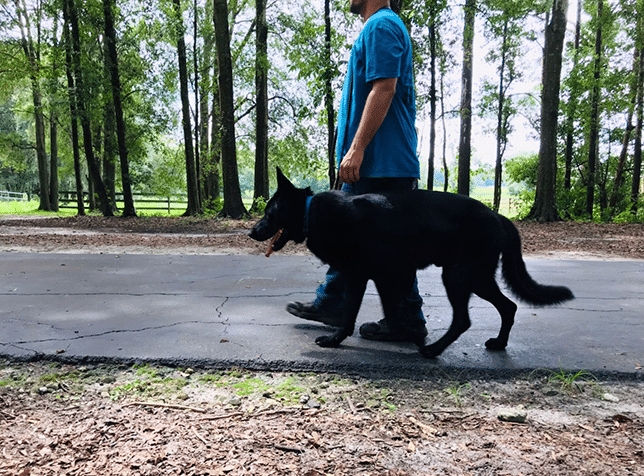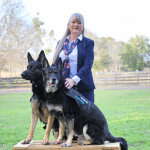At Guardian Angels, we teach the dog to walk nicely on the leash by first teaching them to be attentive to us. There is no collar or leash involved in the beginning. We use a yummy soft treat to reward them for their good behavior. It’s important to avoid crunchy treats because they take too long for the dog to chew, and by the time they finish them, they’ve forgotten what they were being rewarded for.
How to Teach Your Dog the Heel Command
Before you begin practicing any exercise with your dog, we recommend:
- Make sure the dog has had a potty break.
- He is familiar with his surroundings because he will need to process anything new.
- He’s not on a full stomach, so they are more engaged with the treat.
To begin, you need to teach your dog how to be in the correct position.
To heel comfortably with a dog, their neck and shoulders should be even with your left leg. If they get any further out in front of you, you can no longer turn left without tripping over the dog.
What you want to do when teaching any type of command is to set a foundation for positive reinforcement. By holding your treat with your arm extended directly down next to your leg, exactly where you want the dog to get the treat from, you are showing him where he needs to be.
As you walk, the dog is nibbling the treat in the correct position. You’re letting him have little nibbles of that treat as you take a few steps. After a few steps, stop and give them the rest of that treat while telling him how good he is. Teaching a dog to heel is a process of baby steps that lead up to the successful end result.
Once he’s walking next to you nicely, you can teach him to sit by putting the treat right up to his nose and slowly edging back and up a little bit at the same time to align the body into a sitting position.
The nose goes where the treat goes, and the body follows! If your positioning is correct with your treat, you will be able to ask the dog to put his body into whatever position you are asking for, from a correct heel position to sitting, to laying down, etc.
When to Add the Collar and Leash
Once the dog is walking nicely and listening to you, you can now add a collar and leash. If you don’t teach them how to heel first, when you add a collar and leash for the first time, the dog may thrash or buck fighting you while you pull on the leash to drag them along. While the dog may eventually give up and walk with you, there is no need for this traumatic experience.
Starting with a collar and leash is not teaching the dog the basic foundation. You have not explained in advance what the expectation is so you have not made this a simple transition. You have also skipped teaching him where to walk and not to pull, so while he may finally walk on the leash, he/she is probably not in a nice position.
The heel command is important because you don’t want to have tension on the leash while walking your dog. If there is tension on the leash, the dog knows where you are and doesn’t need to pay attention to you. We want the dog to be engaged with us, not the man-made equipment. If they are engaged with us, they are not going to be pulling or dragging.
To us at Guardian Angels, the collar and leash are nothing but legally required ornaments. Since we train dogs for people with disabilities, they can’t drag people around because the recipient could get injured. Recipients need to be able to lead normal lives, so the dog needs to stand quietly and walk quietly with their recipient.
Interested in Learning More About Medical Service Dogs? Contact us Today!
At Guardian Angels, we are happy to answer any questions you may have about medical service dogs. Please contact us today with any questions.
- How to Take Advantage of the CTU Patriot Scholarship - April 5, 2024
- Benefits of Service Dogs for Veterans - April 3, 2024
- The Art of Matching: How We Pair Service Dogs - March 19, 2024





